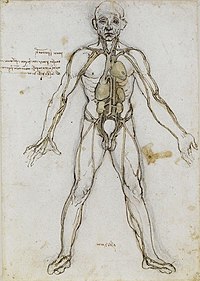| Bone
|
Cranial fossa
|
Foramina
|
Number
|
Vessels
|
Nerves
|
| frontal |
- |
supraorbital foramen |
2 |
supraorbital artery supraorbital vein |
supraorbital nerve
|
| frontal |
anterior cranial fossa |
foramen cecum |
1 |
emissary veins to superior sagittal sinus from the upper part of the nose |
|
| ethmoid |
anterior cranial fossa (osama) |
foramina of cribriform plate |
~20 |
- |
olfactory nerve bundles (I)
|
| ethmoid |
anterior cranial fossa |
anterior ethmoidal foramen |
2 |
anterior ethmoidal artery
anterior ethmoidal vein |
anterior ethmoidal nerve
|
| ethmoid |
anterior cranial fossa |
posterior ethmoidal foramen |
2 |
posterior ethmoidal artery
posterior ethmoidal vein |
posterior ethmoidal nerve
|
| sphenoid |
- |
optic canal |
2 |
ophthalmic artery |
optic nerve (II)
|
| sphenoid |
middle cranial fossa |
superior orbital fissure |
2 |
superior ophthalmic vein |
oculomotor nerve (III)
trochlear nerve (IV)
lacrimal, frontal and nasociliary branches of ophthalmic nerve (V1)
abducent nerve (VI)
|
| sphenoid |
middle cranial fossa |
foramen rotundum |
2 |
- |
maxillary nerve (V2)
|
| maxilla |
- |
incisive foramen/canal/Stenson/Scarpa |
4 |
terminal branch of descending palatine artery |
Terminal part of nasopalatine nerve (V2)
|
| palatine |
- |
greater palatine foramen |
2 |
greater palatine artery
greater palatine vein |
greater palatine nerve
|
| palatine and sphenoid |
- |
foramen sphenopalatinum |
2 |
sphenopalatine artery
sphenopalatine vein |
nasopalatine nerve
rami nasales posteriores superiores (V2)
|
| palatine and maxilla |
- |
lesser palatine foramina |
4 |
lesser palatine arteries
lesser palatine vein |
lesser palatine nerve, greater palatine nerve
|
| sphenoid and maxilla |
- |
inferior orbital fissure |
2 |
inferior ophthalmic veins
infraorbital artery
infraorbital vein, tributary of pterygoid plexus |
zygomatic nerve and infraorbital nerve of maxillary nerve (V2)
orbital branches of pterygopalatine ganglion
|
| maxilla |
- |
infraorbital foramen |
2 |
infraorbital artery
infraorbital vein, tributary of pterygoid plexus |
infraorbital nerve
|
| sphenoid |
middle cranial fossa |
foramen ovale |
2 |
accessory meningeal artery, emissary vein connecting cavernous sinus with pterygoid plexus |
mandibular nerve (V3)
lesser petrosal nerve (occasionally)
|
| sphenoid |
middle cranial fossa |
foramen spinosum |
2 |
middle meningeal artery |
meningeal branch of the mandibular nerve (V3)
|
| sphenoid |
middle cranial fossa |
foramen lacerum |
2 |
artery of pterygoid canal, Meningeal branch of ascending pharyngeal artery, emissary vein |
nerve of pterygoid canal through its anterior wall
|
| temporal |
middle cranial fossa |
carotid canal |
2 |
internal carotid artery |
internal carotid plexus, sympathetics from the superior cervical ganglion
|
| temporal |
posterior cranial fossa |
internal acoustic meatus |
2 |
labyrinthine artery |
facial nerve (VII), vestibulocochlear nerve (VIII)
|
| temporal |
posterior cranial fossa |
jugular foramen |
2 |
internal jugular vein, inferior petrosal sinus, sigmoid sinus |
glossopharyngeal nerve (IX), vagus nerve (X), accessory nerve (XI)
|
| temporal |
posterior cranial fossa |
stylomastoid foramen |
2 |
stylomastoid artery |
facial nerve (VII)
|
| occipital |
posterior cranial fossa |
hypoglossal canal |
2 |
- |
hypoglossal nerve (XII)
|
| occipital |
posterior cranial fossa |
foramen magnum |
1 |
anterior and posterior spinal arteries, vertebral arteries |
lowest part of medulla oblongata, three meninges, ascending spinal fibers of accessory nerve (XI)
|
| occipital |
posterior cranial fossa |
condylar canal |
1 |
occipital emissary vein, meningeal branch of occipital artery |
|


 Base of the skull, upper surface
Base of the skull, upper surface
 Base of the skull, inferior surface, attachment of muscles marked in red
Base of the skull, inferior surface, attachment of muscles marked in red